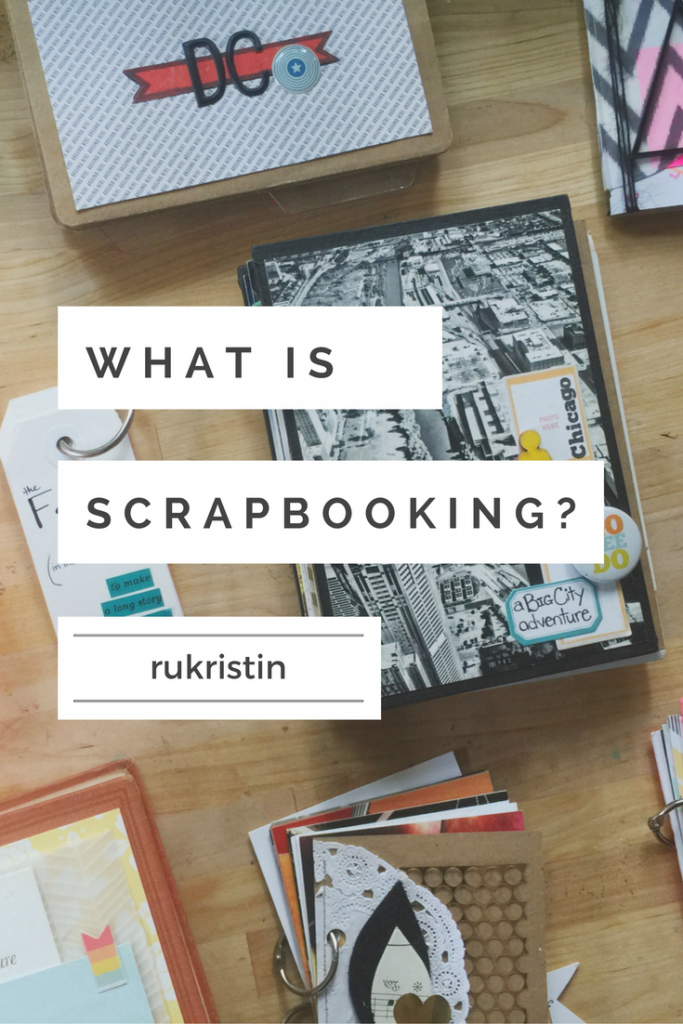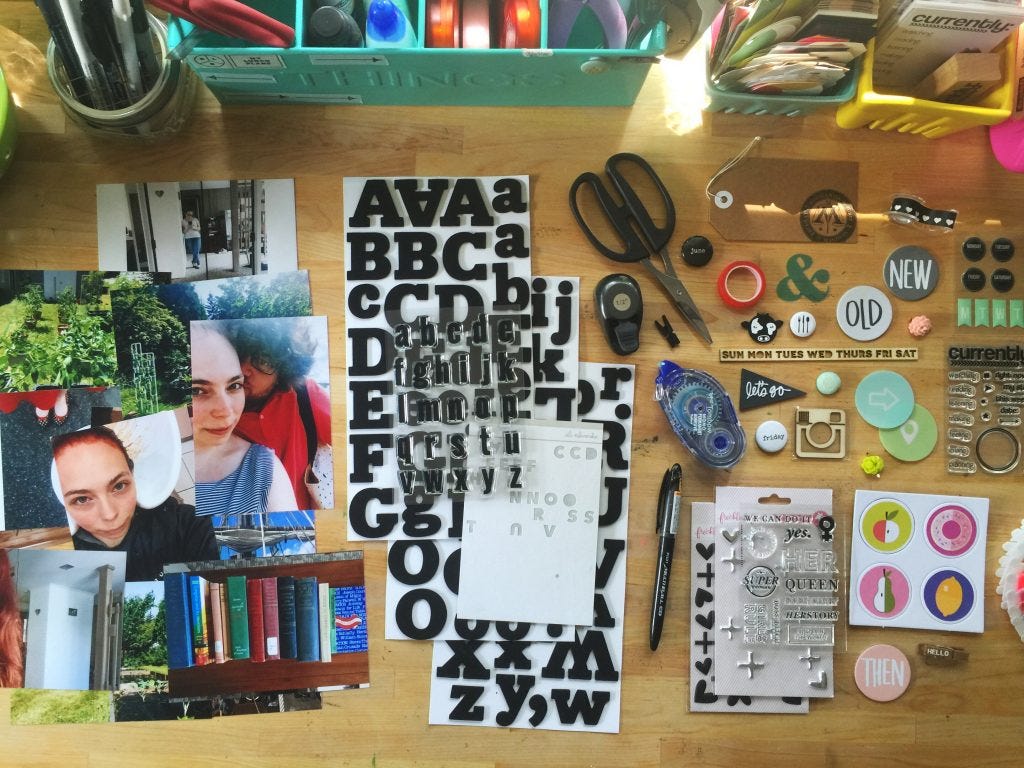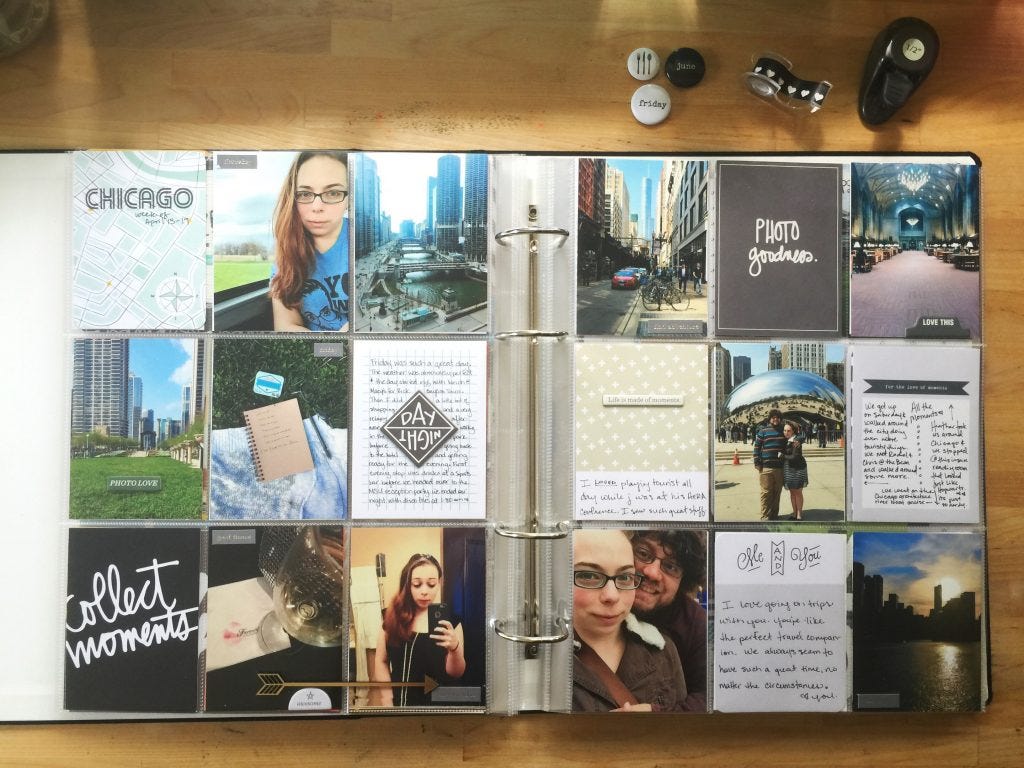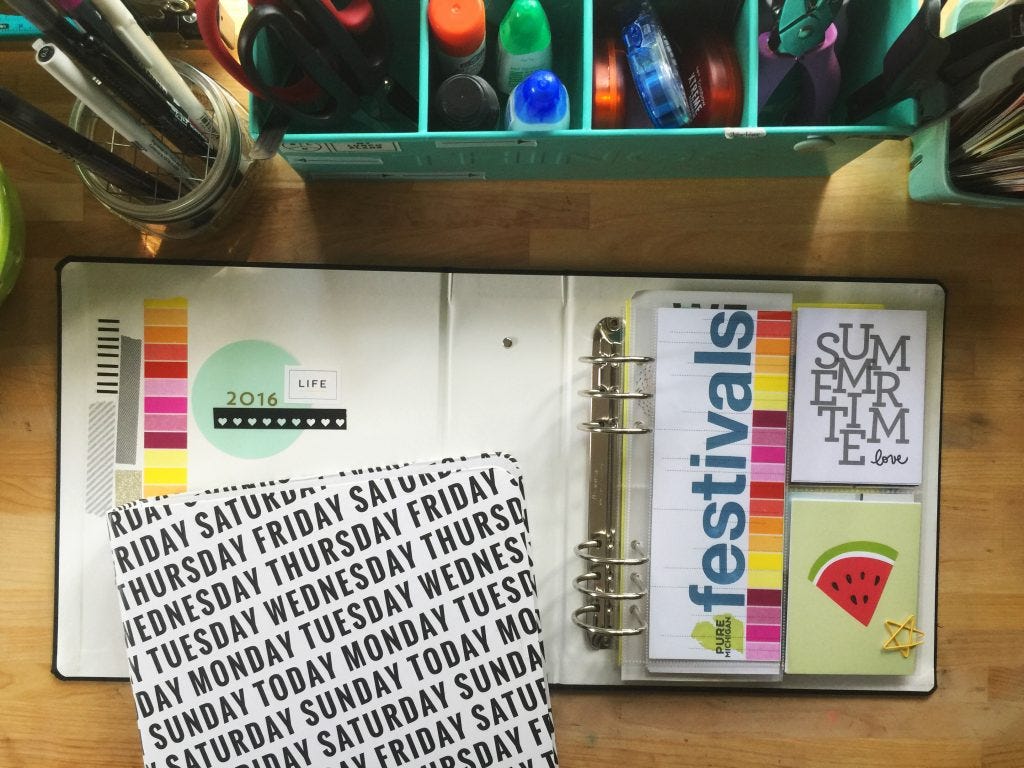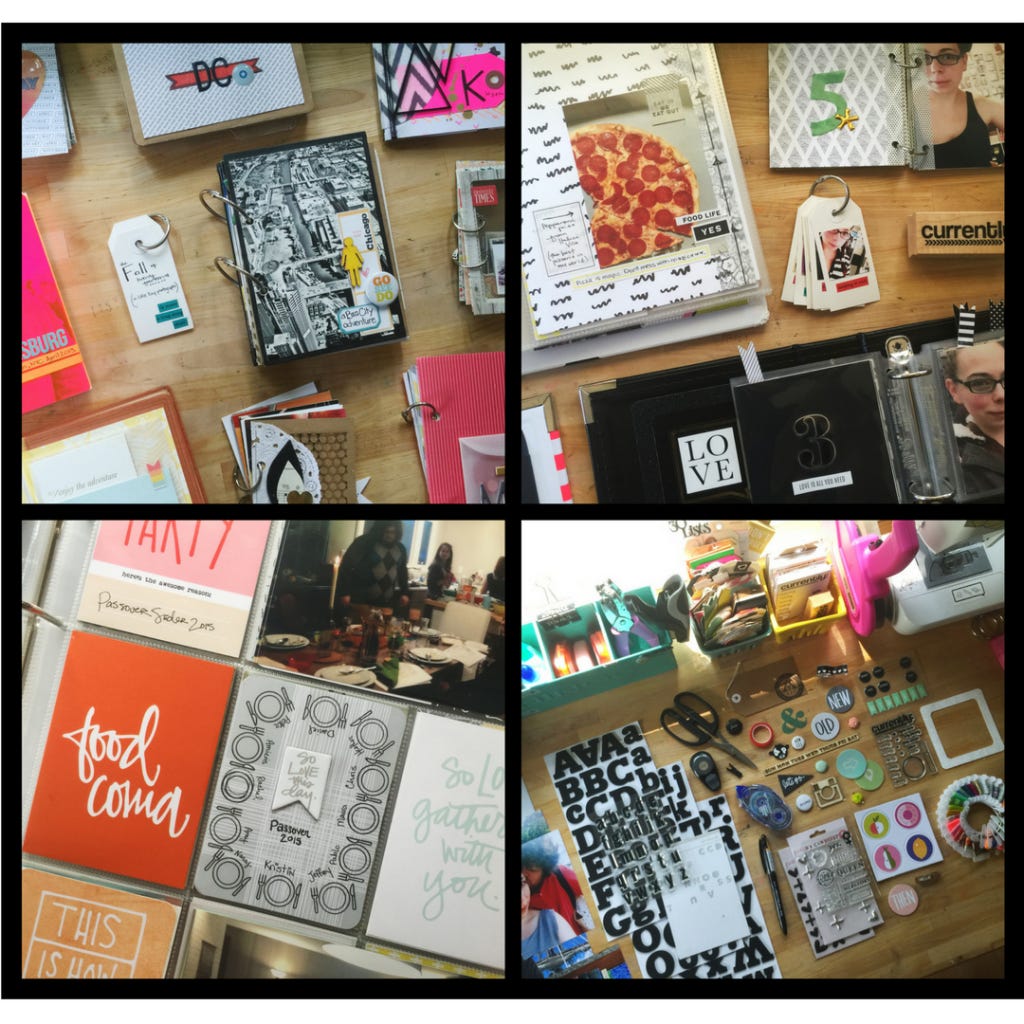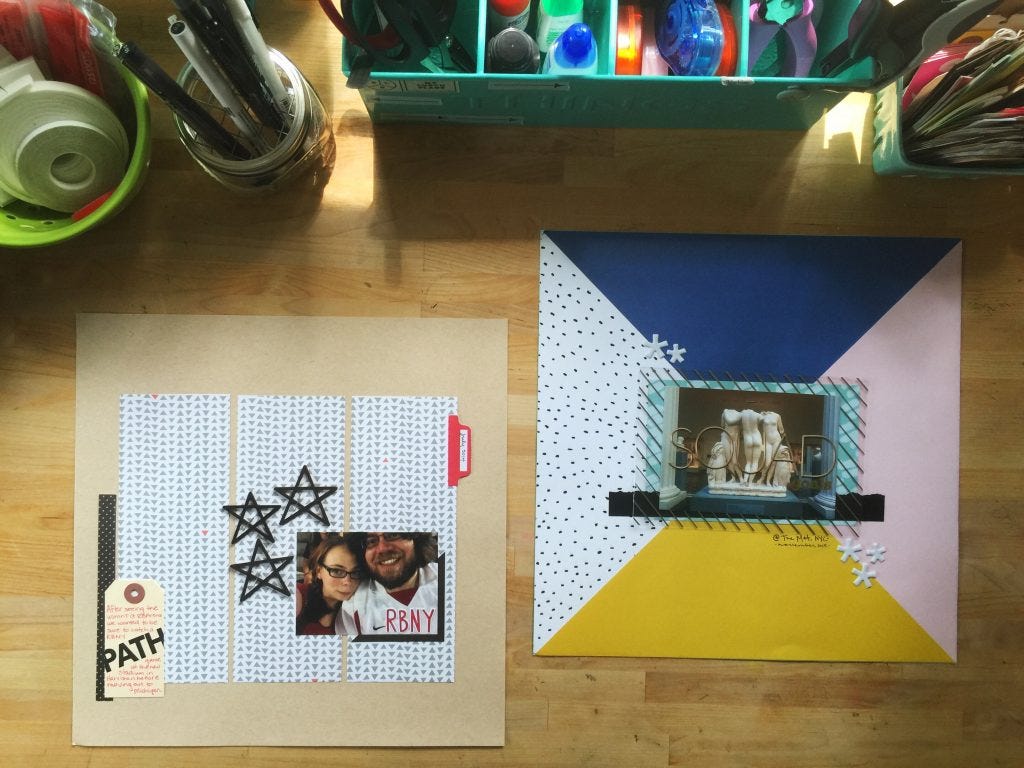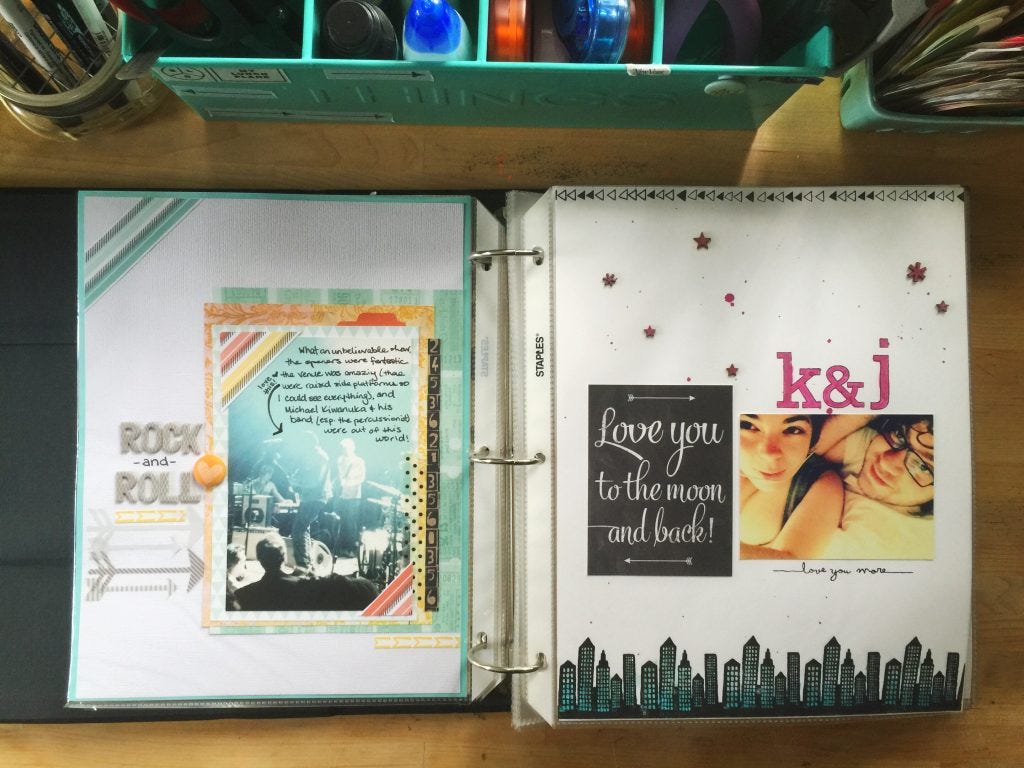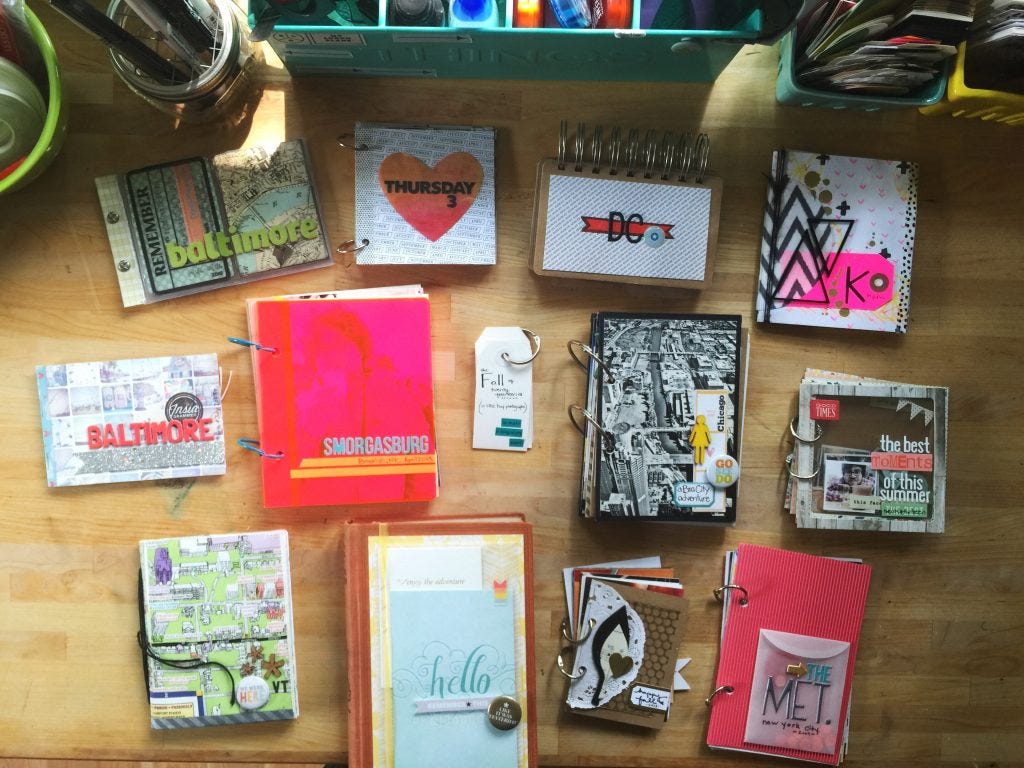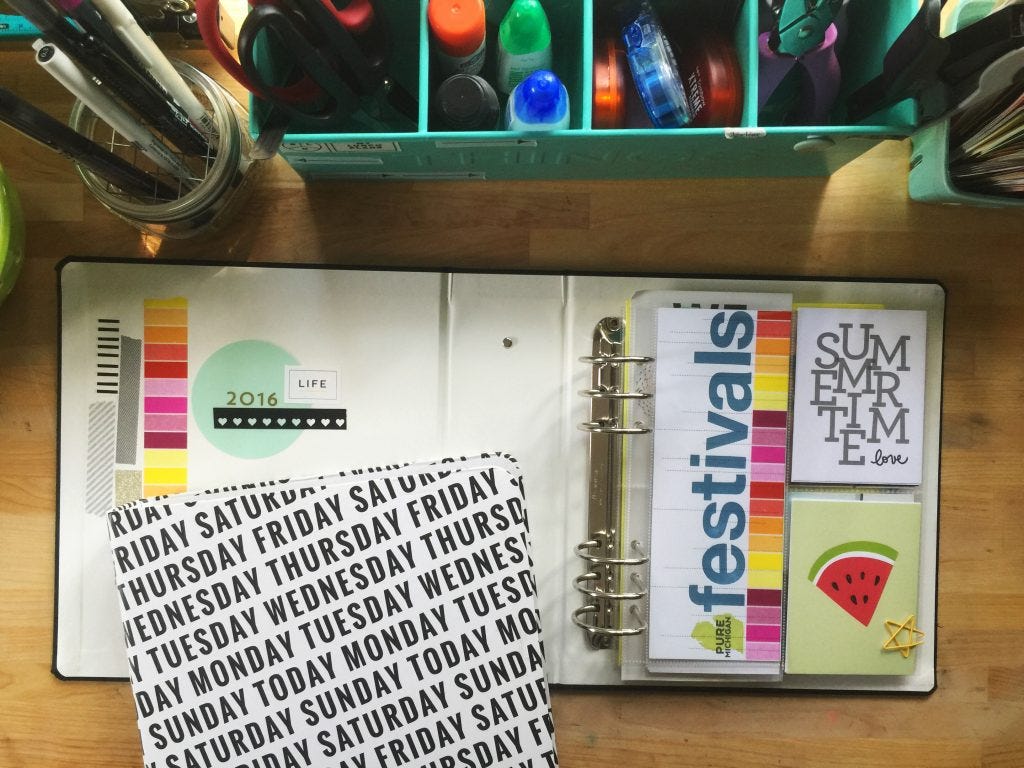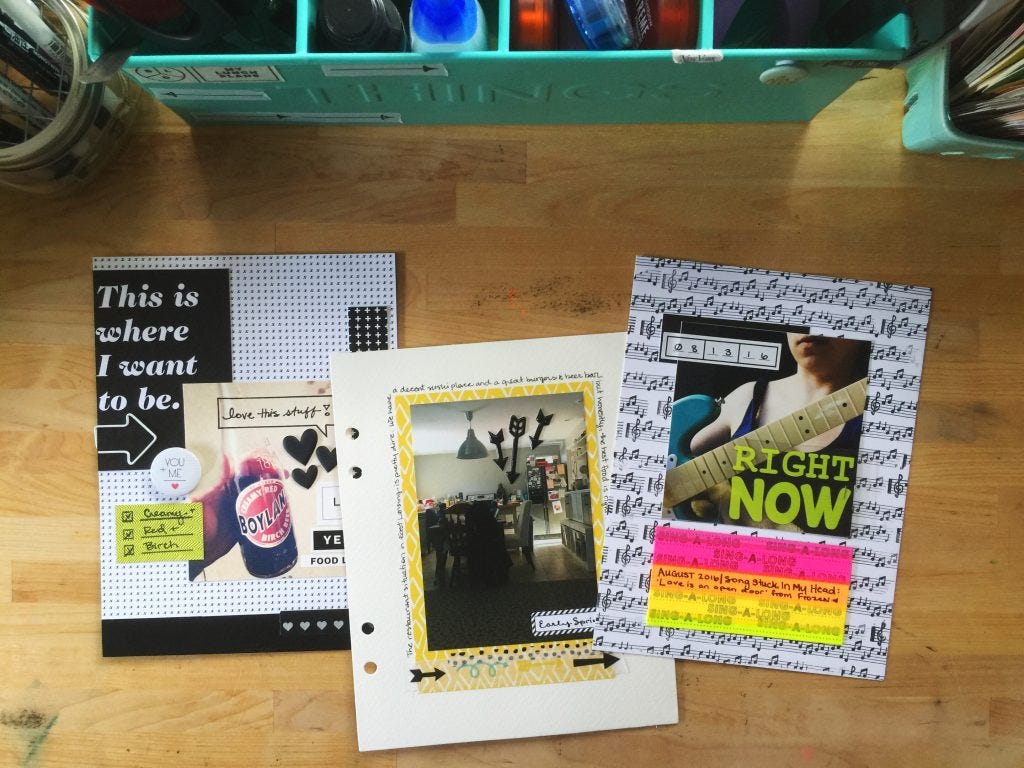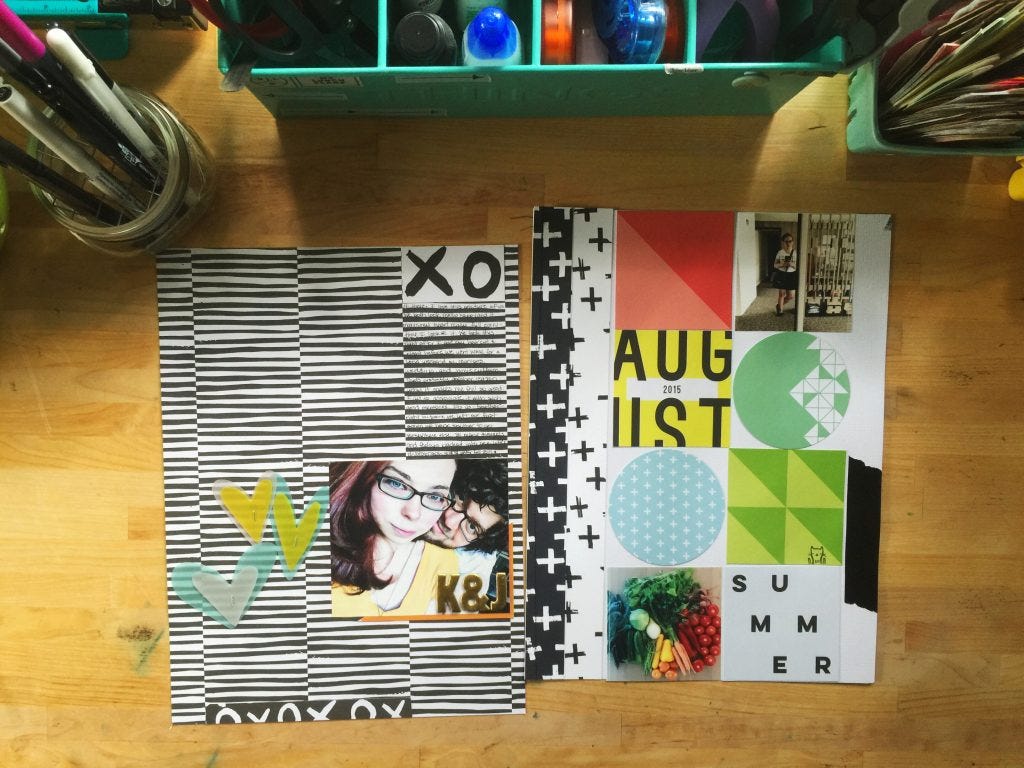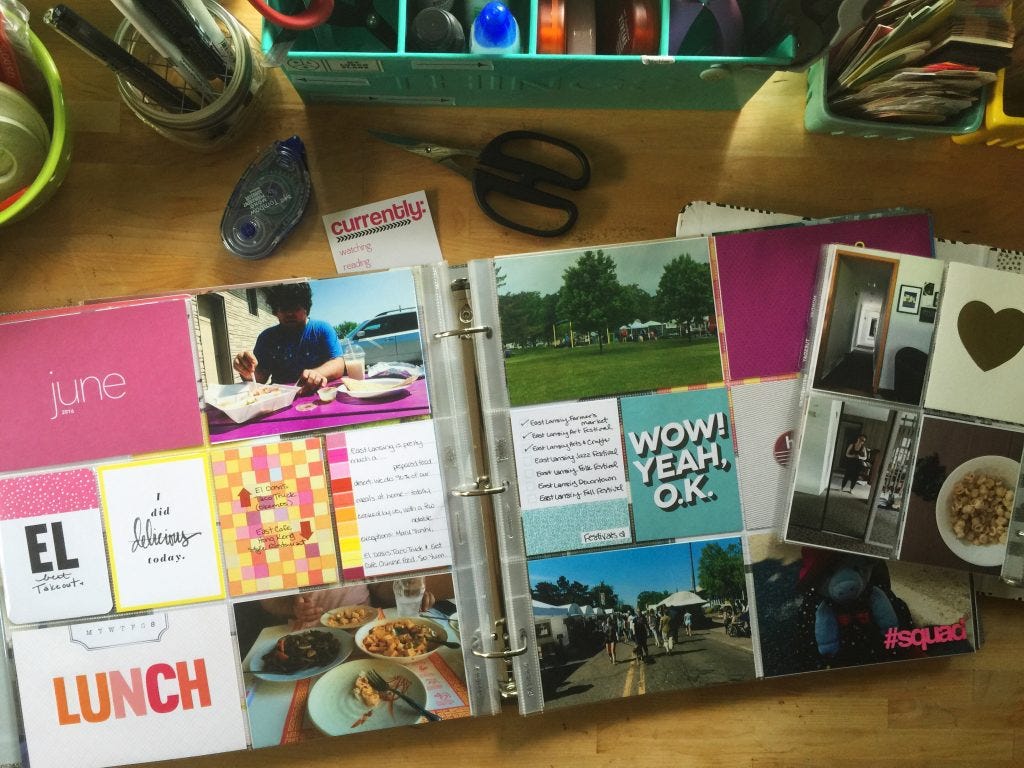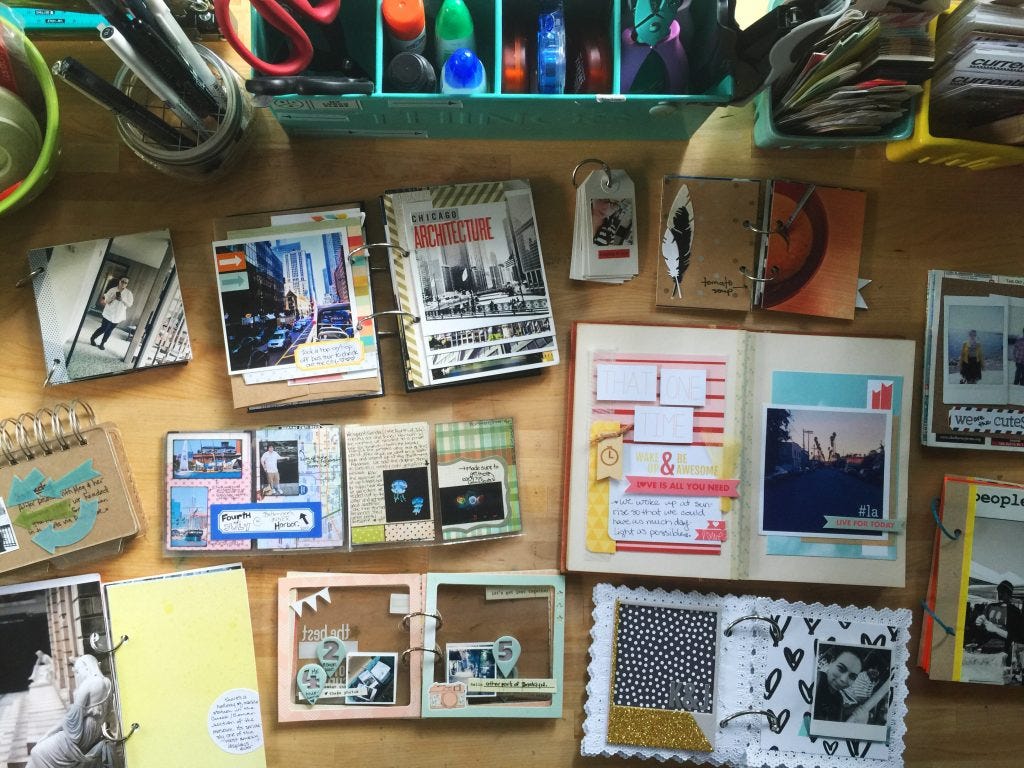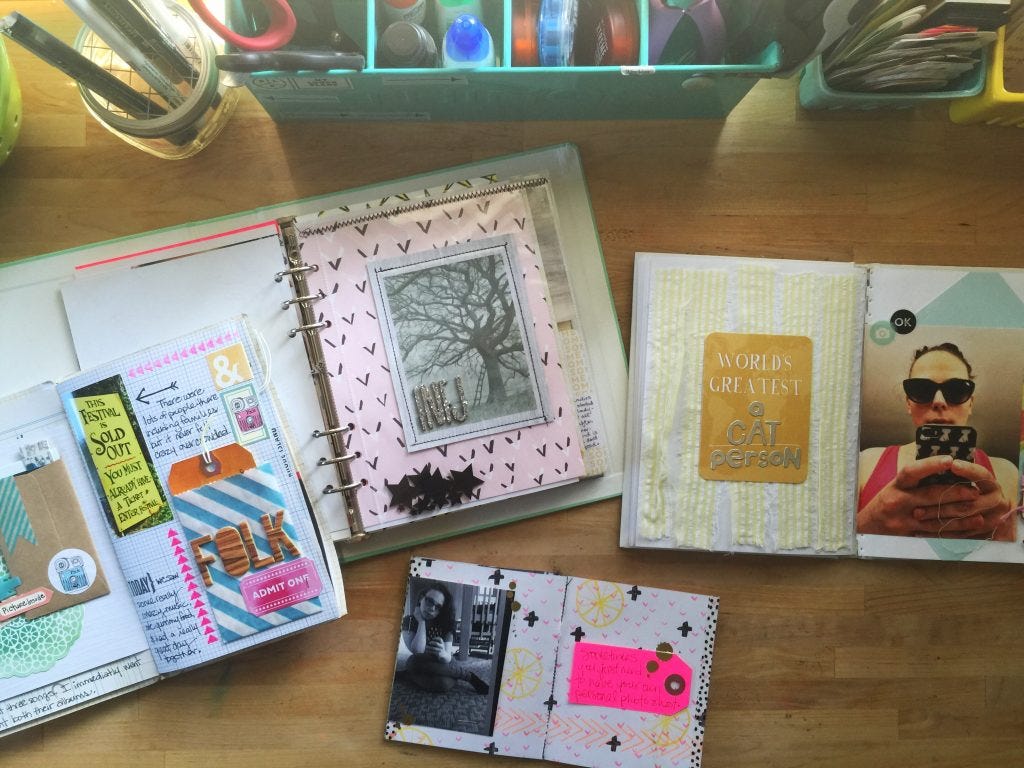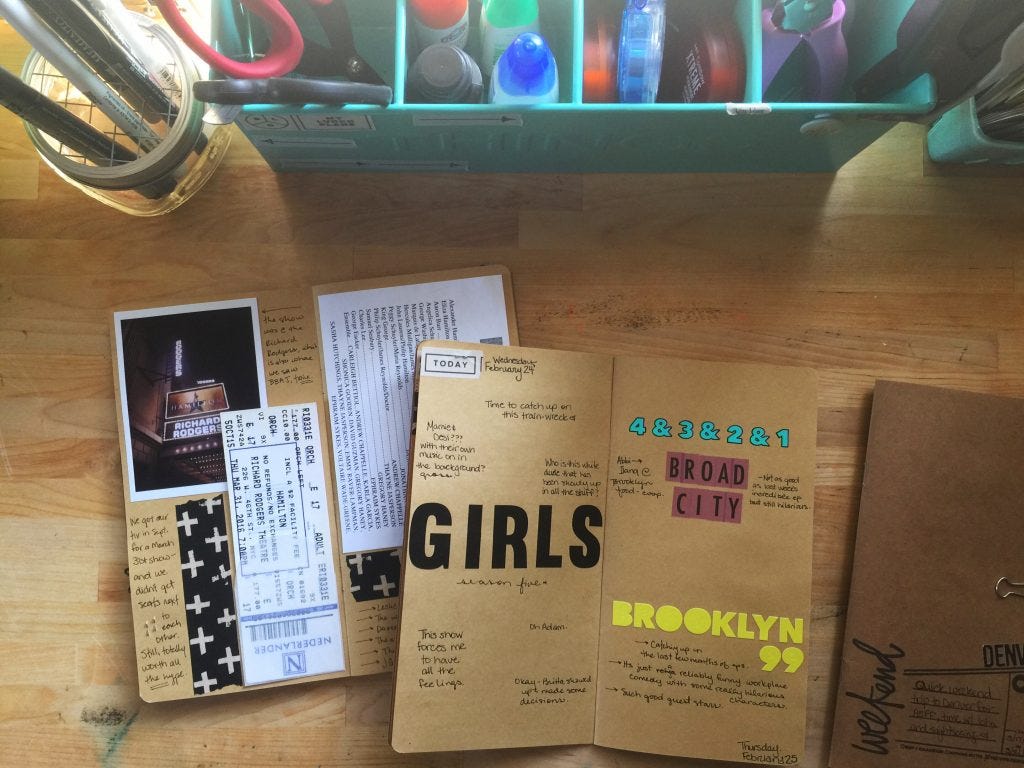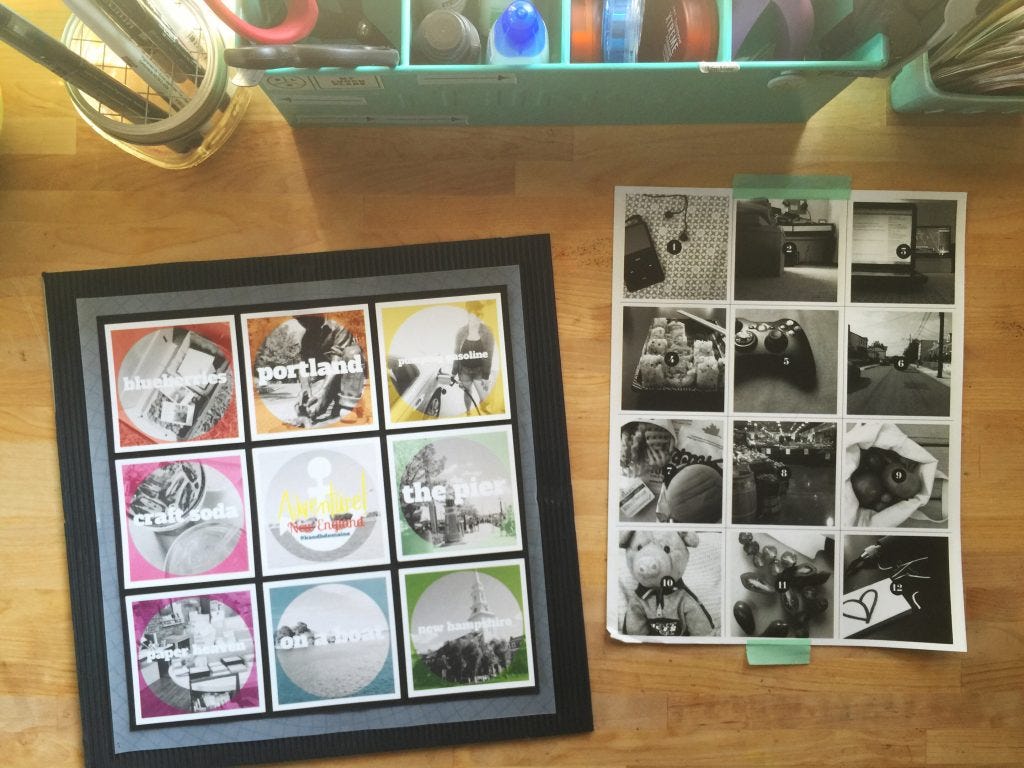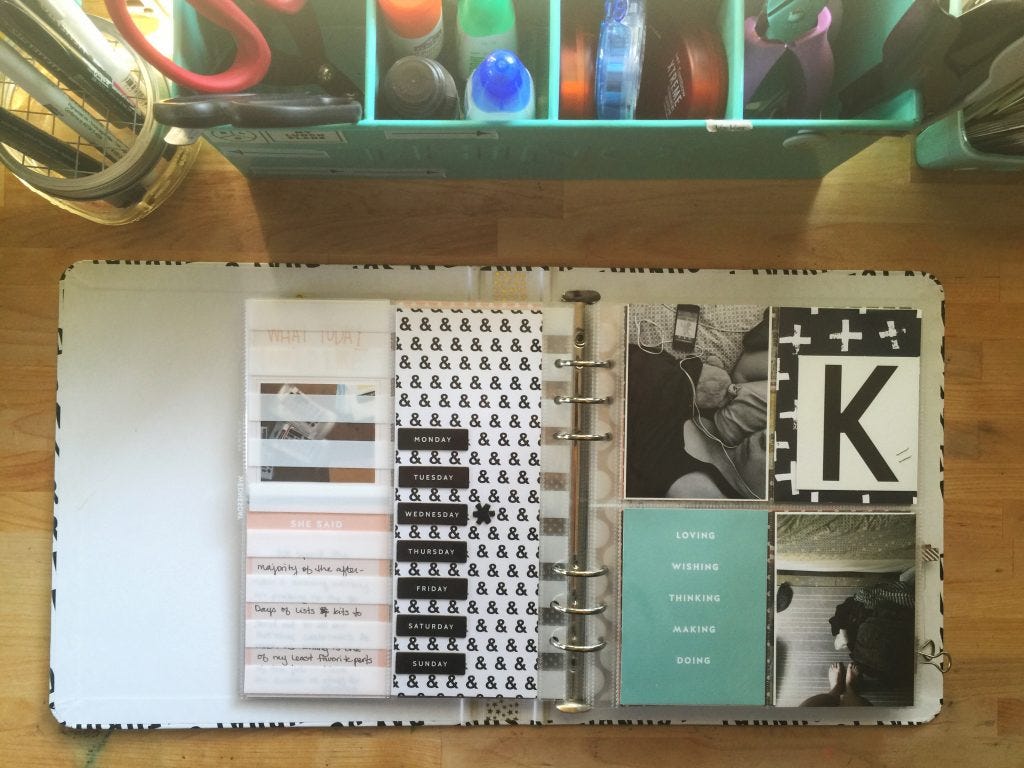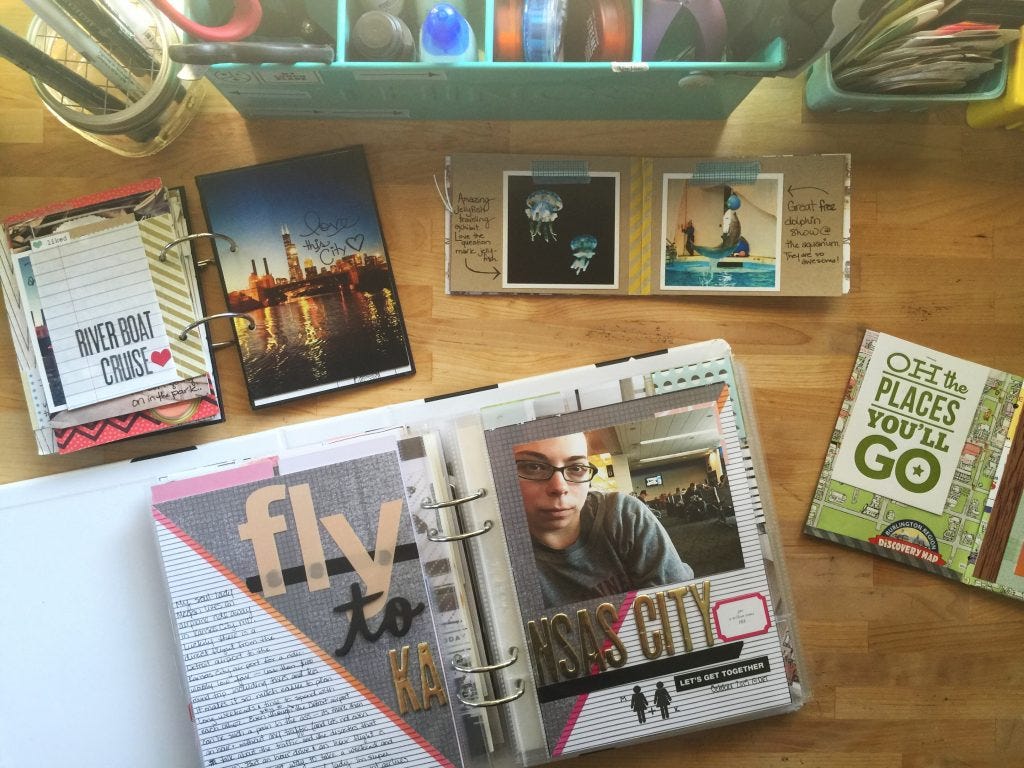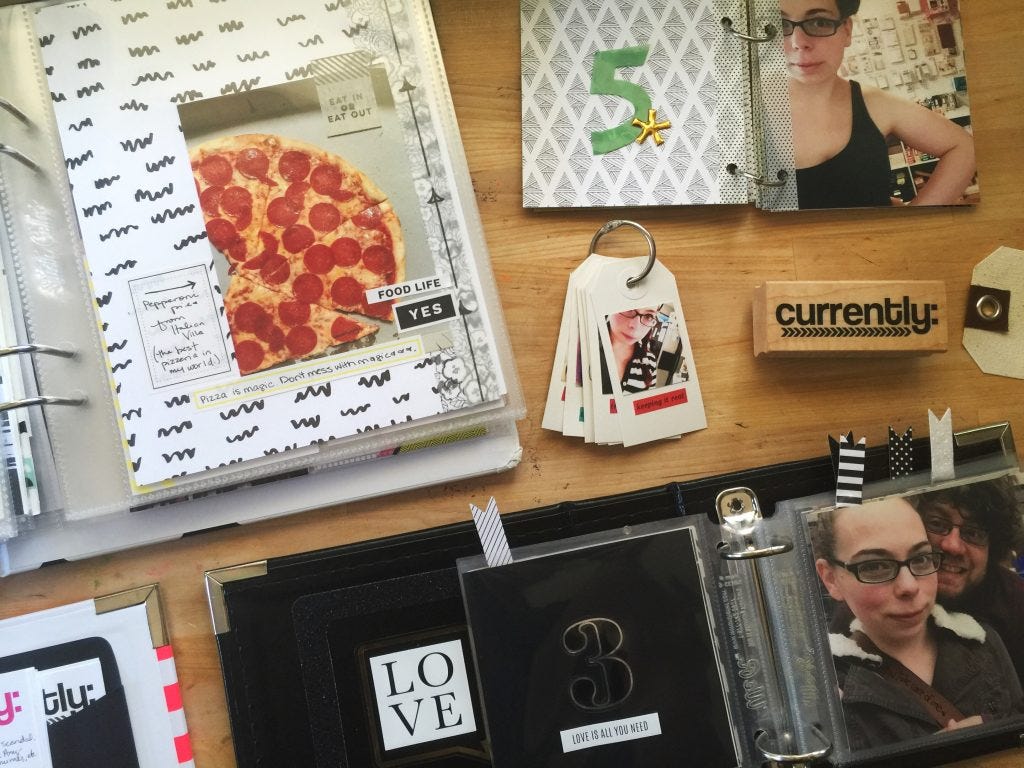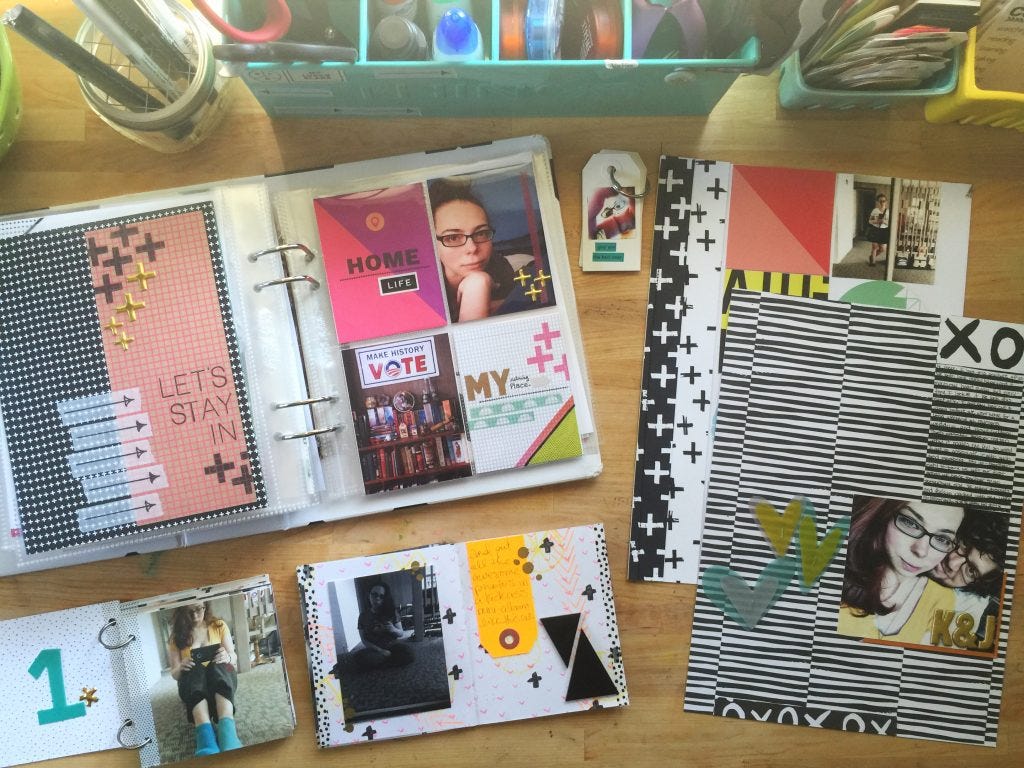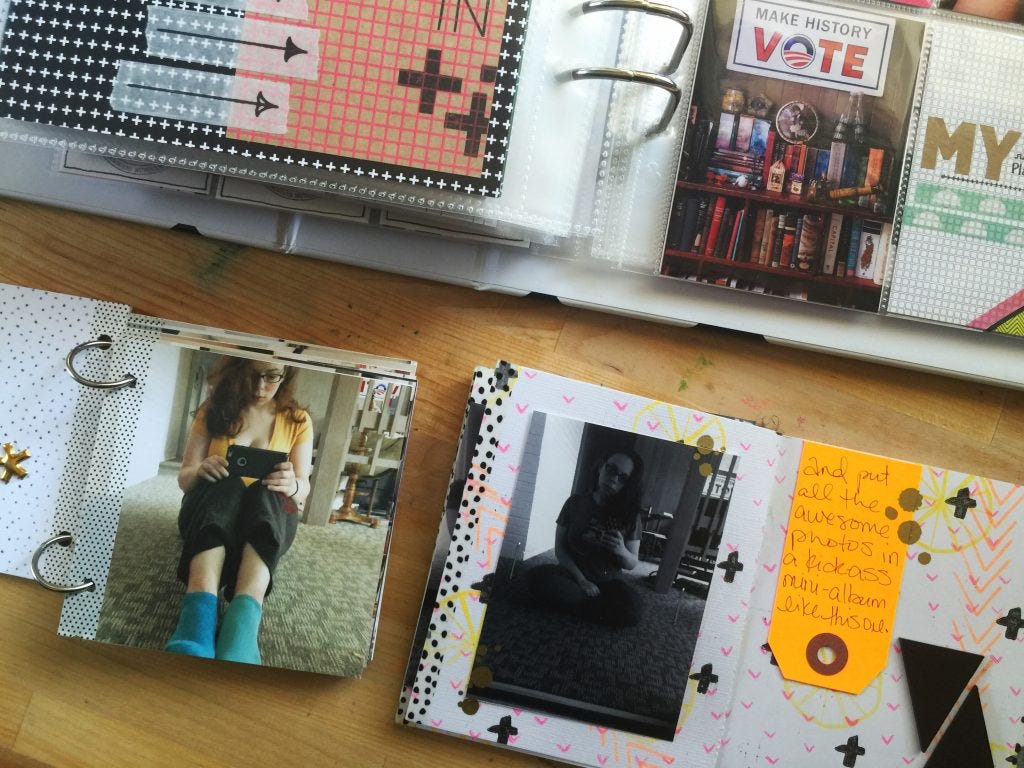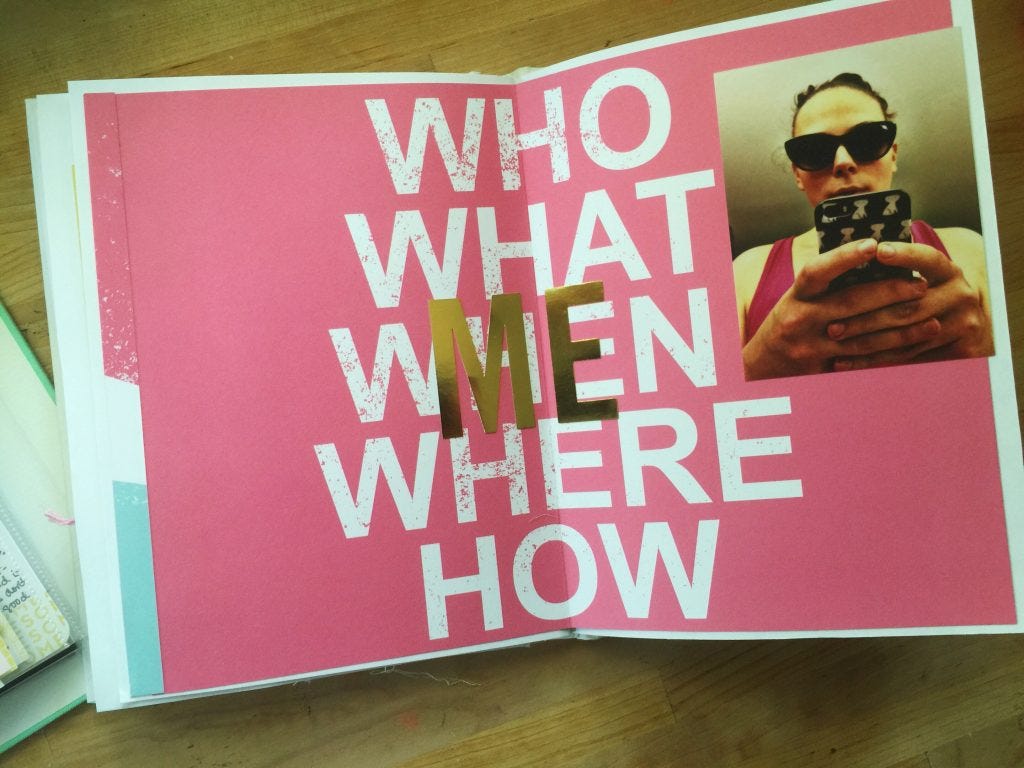Updated with a few notes in November 2023.
Bad News: There really isn’t a truly satisfactory answer to the question What is Scrapbooking? I’ve been writing versions of answers to this question for almost 20 years now, and my answer today might still be different than my answer tomorrow.
Good News: While there may not be one grand unified theory of scrapbooking, here’s a quick rundown of how I see it, and a few guidelines for the most key principles of scrapbooking - project size, art style and narrative approach. And because this is my space, you will of course be hearing about how Feminist Scrapbooking influences all of this. Join me below!
Scrapbooking is a method of documenting your life where you take your favorite photos and pair them up with your favorite paper supplies, then throw in some words to really pull the story together, and add in some bits of life in order to finish it up. It’s a really fabulous way to share the stories of your life.
Scrapbooks come in all shapes and sizes. Whatever your style (and whatever your life looks like), there is a way for you to turn photos, words, and your favorite paper supplies into scrapbooks that represent your right-now life. You can create meaningful art, sharing your stories in a way that captures your life in a completely unique way.
Scrapbooking has been around forever - we’ve been putting pictures and stories in books since we’ve had pictures and stories to put into books. As we’ve found new and novel ways to take photos and tell stories, the practice of cataloging and collecting them has evolved over the years into the modern sense of scrapbooking we understand today.
From patterned paper to washi tape to puffy stickers and more, there are hundreds of thousands of products created specifically for scrapbooking, to cater to the diverse group of humans who practice this art.
Feminist scrapbooking encourages all people, regardless of income, race, gender, marital status, height, weight, sexuality, gender, etc. to tell their stories in a way that works for them. Through photos, words, creative supplies, and the bits of life, we have the power to turn ordinary moments into treasured lifetime memories.
You choose how scrapbooking works for you.
There is no wrong way to scrapbook your life. The most important thing when getting started is to give yourself the room to be a beginner. Try things out, see what you like and what you don’t like. Knowing what you’re into (and even more what you’re not) is a huge help when you’re trying to be creative with your stories.
Maybe you want to create a big traditional 12x12 style scrapbook album -- perfect for sitting on the couch and flipping through on your lap.
Maybe you’re more of a mini-album girl, documenting each of her special adventures in its own unique book.
Perhaps you’re the type of scrapbooker who loves pocket pages and documenting her day-to-day life.
Or maybe you love planning and calendars and your perfect scrapbook is a planner with some photos, journaling and your favorite paper supplies.
All ways of scrapbooking and documenting your life (and others) are just as valid as any of the others. There is no “right” way to do this, just as their isn’t a wrong way to do it either! The only thing that matters is that you’re trying, exploring, and reflecting.
Guess what: It’s okay if you don’t know how you want to scrapbook your life right now or even a year from now. The best way to learn which type of scrapbooking works best for you is to try it out. Make a few traditional scrapbook layouts, take a mini-album class, dedicate a time period to documenting your day-to-day life.
While you’re making, think about the things you like and think about the things you dislike. Jot down a mental note (or honestly maybe a physical note) so you remember for your next project. Maybe you don’t love long-form journaling. Maybe you really love using a bunch of photos, or memorabilia you picked up on your latest adventure.
One of the best parts of having a hobby like scrapbooking is the way that you learn and grow through your craft. Start with some supplies you love -- and go from there.
Types of Scrapbooks
Now that we’ve talked about how there’s no perfect way to scrapbook your life, and you can do whatever you want. Let’s take the pressure off and categorize some stuff for ease.
First, we’ll break down some of the different types of scrapbooks out there, including size, style, and narration-specific options. This is definitely not an end-all list, but just a general framework for you to imagine your future scrapbooks.
Size
As we talked about earlier, scrapbooks come in a variety of different sizes. The most common size for traditional scrapbooking is 12x12”. But that’s just the starting point. You can easily convert 12x12” scrapbooking supplies to work with whatever page size you choose.
Many of the scrapbook manufacturers sell sheets of 12x12” paper, so if you go into one of the big box stores and check out their scrapbook section, you’re bound to find stacks and stacks of 12x12” paper. And if that size works for you — awesome. But 12x12” isn’t the right size for every person or every project.
Let’s break down a few of my favorite options:
Large Scrapbooks
Large scrapbooks, like the traditional 12x12” or 8.5x11” size, make a big statement. When you open up a 12x12 album, you have a book that’s almost 2.5 feet wide on your lap/table. These books are meant to be kept as a record, stored and shared over the years.
Large scrapbooks are great for scrapbooking family albums, an annual life album, a series of major life milestones, epic vacation albums, wedding albums, and more.
When you have a ton of photos that need to take up a bunch of space, and an epic story that deserves to be told, go with a large scrapbook.
Large scrapbooks can be overwhelming, and sometimes I find it easier to shrink it down just a little bit. In addition to 12x12” albums, I’ve really enjoyed creating in both the 8.5x11” and 9x12” sizes.
Small Scrapbooks
Smaller scrapbooks (oftentimes called mini-albums) are handheld size albums. 3x4” inches, 4x4” inches, and 4x6” inches are all popular small scrapbook sizes.
Small scrapbooks are great for scrapbooking your favorite selfies, for quick adventure albums, for weekend trips, progression scrapbooks -- where you take the same/similar photographs over a set period of time, and any other story that you want to share in a small but meaningful way.
These mini-albums are an easy DIY project, no bulky album needed. But if you’re not the DIY type, you can definitely find smaller pre-made albums to share your stories in as well.
Medium Sized Scrapbooks
Medium sized scrapbooks are…wait for it…in between small scrapbooks and large scrapbooks. They’re very chameleon like. Sometimes they’ll seem like an oversized mini-album and sometimes they’ll seem like a miniature version of a large scrapbook. That’s the beauty.
It’s easy to make medium sized scrapbooks into whatever you want them to be. Medium sized scrapbooks are great for when you’re thinking a mini-album style -- but you have way too many photos. They’re also great when you’re thinking that you want more of a traditional album feel, but without the size (or the effort).
For me — it’s definitely the Goldilocks option. I’ve been using these medium sized 6x8 scrapbook albums for a majority of my documenting. My everyday stories are in an annual 6x8 chronological album. My favorite Book of Me albums are in a 6x8 book as well.
It’s a fun size and it goes quick. You can make a pretty epic medium sized scrapbook in much less time than usual. There is a good amount of supplies out there for medium sized scrapbooks. You can find albums that come in sizes like 6x6”, 6x8”, 8x8” and others (there are popular Travelers’ Notebook sized albums as well).
In addition to albums you can find a number of paper pads manufactured in smaller sizes as well. These smaller paper pads can be great as they’re usually a little bit different than the 12x12 papers offered in the same collection.
No matter what size scrapbook you’re working on, there are tips and tricks to making supplies work for you. For example, even though I mostly scrapbook in the 6x8 size or smaller, I still love using 12x12 papers and cutting them down to the size I need. Then I have extra scraps for my next project. It’s like the wholesale version of scrapbooking. Buy in bulk, use what you need, and save the rest for later.
Style
Now that we’ve talked about size, let's move on to style. There are an infinite number of scrapbook styles, (and this isn’t even getting into your personal style) but I’m going to break it down into a couple of different categories so you differentiate a little bit.
Traditional
Traditional scrapbooks are what you think of when the word scrapbooking comes to mind. There is a sheet of pretty paper, it has one or more photographs on it. Maybe there are some other sheets of pretty paper or embellishments. There’s probably a little bit of journaling to explain the photos or further the story.
This is the basic mold from which every other style is created. You start with a single sheet of paper (whatever size you’re working on). Next (or in whatever order you want) you add your photographs. You add a title and some journaling. Maybe you add more pretty paper or embellishments. But that’s the basic formula:
Photos + words + creative supplies + bits of life = scrapbooking
Pocket Page
Pocket page scrapbooks, popularized by Becky Higgins’ Project Life system of memory-keeping, use segmented page protectors to create individual pockets for photographs, journaling cards, memorabilia, etc. These albums come in a variety of sizes from 4x4 through 12x12.
Pocket page albums make memory-keeping more structured. By giving you a specific formation of pockets you’ll be forced to put your photos in some of them, and fill the rest with journaling cards, memorabilia, etc. It removes some of the stress of the blank page and gives you a guideline to start.
Pocket page albums also seamlessly integrate with traditional scrapbooks. It’s not uncommon to see pocket pages and traditional pages together in my albums. I love the freedom of a blank page, but I also really love the structure, as well as sliding everything in right where it belongs.
Mini-Albums
Mini-albums, for the most part, are just small, hand-held size scrapbooks. They’re very easy to DIY. You can make a mini-album using a single sheet of paper if you were so inclined. They’re cute, they’re little, and they’re the perfect way to tell a quick story when a single scrapbook page isn’t enough.
Mini-albums can truly be anything you want them to be. There are an infinite number of ways to put a mini-album together. A few of my favorite techniques are:
Binder Rings: Mini-album pages have holes punched in the side and are looped around binder rings/placed in albums. Coil bound albums (using a tool like the Cinch or Bind-it-All are similar.
Accordion Fold Album: Mini-album pages are folded back and forth, with additional folded strips added to make the mini-album longer if necessary.
Altered Books: Mini-album pages are created by removing some pages, and gluing other pages together to create a board-like-book that you can document inside.
Pre-Made Journals: Mini-album pages already exist inside of a pre-made journal. Sometimes pages are added or removed to make a pre-made product work better for a specific purpose.
Mini-albums are one of my favorite ways to scrapbook a story. I love knowing that there is a definite end to this mini-album and when I’m done I’ll have a finished product.
Mini-albums are also a great way to use up scrap paper, to add lots of memorabilia, or to use bulky embellishments that otherwise wouldn’t look good underneath page protectors.
Art-Journals
Even though art-journaling can be considered an entirely separate craft, I added it here because I think it’s important to think about the overlapping characteristics.
An art-journal is just that, a journal that you do art in. Many art-journals are a creative means of introspection. Whether it’s paper art, painting, drawing, stenciling, or any of the other arts/crafts techniques that appeal to you.
Almost all art-journaling techniques can be copied over into your scrapbook pages. Whether you paint on an individual scrapbook page or create a mini-album out of a paper bag and memorabilia, you can incorporate art-journaling into your scrapbooks.
If you’re already an art-journaler and you’re looking to expand into the scrapbook arena, all you need to do is start working some photos into your art-journals. Even then, a scrapbook doesn’t even technically need to have photos. Maybe you’d like to paint your trip to the Grand Canyon, or perhaps you’d like to cut out the photos from the brochures or playbills you picked up.
I've created several art journals over the years, with topics ranging from a folk music festival to a selfie photo shoot I had in my living room. By expanding our scrapbooking world to include art-journaling and all of the fun and time-worthy techniques that go with it, it’s super easy to customize our own scrapbooks even more.
If art-journaling seems overwhelming to you, and you don’t know where to start, my suggestion is to start with a single product or technique and slowly incorporate that into your projects. See what you like about it, see what you don’t like about it, and move forward from there.
Traveler's Notebooks
Traveler’s Notebooks are a newer trend in the scrapbook world. They’ve been around forever in travel journaling circles, but they’ve just recently been adopted by scrapbookers as a way to document their own travels (or anything else).
Travelers notebooks are a system of vertical style notebooks, held together in a larger folio. This way several ‘inserts’ are added into a traveler's notebook each documenting a separate trip or event.
I've used traveler's notebooks to document the television I was watching last season, as well as trips to NYC and Denver. Traveler’s Notebooks are a simple and easy way to create an organized documentation of your trip/vacation/life/etc. It’s easy to add as much or little as you need.
It’s also a great method for memory-keeping if you’re short on room. Keep all of your supplies in a neat little pouch and throw it in your purse or your suitcase when you travel.
If you really like this size, but documenting in a notebook isn’t for you — there are scrapbook albums with page protectors that come in this size as well!
Digital Scrapbooks
Digital scrapbooking has been around for more than a decade. Photos and computerized graphic images are pieced together using photo editing software to create a digital version of the traditional scrapbook page.
Digital pages can be printed out and placed in a traditional scrapbook album, or printed out in a digital photo book of their own.
Digital scrapbooking can be as simple as adding some text to your favorite photo. Snapchat filters are a great example of a fleeting form of digital scrapbooking. If you've been storing all of your best photographs on your phone or on your hard drive, digital scrapbooking can be an easy transition into memory-keeping.
Digital scrapbooking is done with computer photo programs like Photoshop, Canva, or GIMP, as well as tablets, mobile phones, and other e-devices.
Hybrid scrapbooking, using some digital elements in your paper scrapbooks, is a great way to integrate digital supplies into your scrapbooks. There are a ton of printable scrapbook supplies available on the internet; printable papers, journaling cards, and more. It also opens up an infinite amount of options for you to truly customize your scrapbooks.
One of my favorite digital scrapbooking tips is: use the computer to type and print out your journaling. You'll be able to edit it for grammar, spelling, and size; useful for anyone who needs their journaling to be perfect.
Narrative
Almost every scrapbook story can fit into one of three categories: everyday stories, adventure stories, or introspective stories. Each story type has it’s own unique traits. Knowing which style your story fits into can make it easier to plan out your project.
Everyday
Everyday stories are the reporter’s version of memory-keeping. It’s the who/what/where/when/why/how of your life. Everyday stories are about the day-to-day happenings of your life.
Everyday scrapbooking captures the details that might otherwise get lost when documenting only the life-milestone stuff. Topics like your home, your job, your favorite meals or places to hang out are all great examples of everyday scrapbooking stories.
Everyday scrapbooking sees the beauty in the stories of our routines.
Adventure
Adventure scrapbooking stories are all about the big events in life. These are the types of stories that you celebrate and tell everyone about. Adventure stories usually benefit from a chronological storyline; here’s what happened first, then here’s what happened after that, and then this final thing happened, but that’s not a steadfast rule.
Wedding albums, baby’s first year albums, epic vacation albums; these are all great examples of adventure stories told through scrapbooking. Maybe your adventure stories might not feel outwardly all that adventurous, but this is about your life, and the big moments in your life are absolutely an adventure and deserve to be celebrated.
Adventure scrapbooking is the highlight reel of our best, special, and most eventful, life-moments.
Introspective
Introspective scrapbook stories are the meta-stories of the scrapbook world. These stories don’t really exist in a specific time or a specific place; instead, they’re more about feelings and emotions.
Introspective scrapbooking is for when you want to tell a story, but that story isn’t really grounded in a specific photo, or a single moment. Maybe you want to document the playlist you’re listening to right now, or the best things about your house, or the television shows you’ve been binge watching.
All about me albums and art-journals are two great examples of creating an introspective scrapbook album. It’s also just as easy to put your introspective scrapbook stories in with your everyday stories and your adventure stories.
Introspective scrapbooking is about feelings and emotions over facts and figures.
There is definitely some overlap in these categories, as well as scrapbook-worthy stories that don’t really fit into any one of these. This is a framework for you to start thinking about the different types of stories you want to scrapbook.
You don’t need to fit your stories into one of these three categories before getting started, but it can be a helpful tool when you’re trying to figure out what direction you want to take with a particular photo or a particular story.
Feminist Scrapbooking
I came up with the term ‘feminist scrapbooking’ years ago in college after trying to reconcile the need to document my life with photos, words, and pretty paper with a lot of toxic beliefs in the scrapbooking community at large.
Scrapbooking was gatekept in a really distinct way, and there was a lot of pushback if you were scrapbooking in a way that deviated from the norm. First and foremost, scrapbooking was seen as this thing that moms did for their families. And if you weren’t married (to a man) and had children — then scrapbooking just wasn’t for you.
I’ve been scrapbooking since I was a sophomore in high school — I clearly was not even thinking about the idea of husbands and children. I was enjoying who I was, the things I got to do, and the friends I had.
Your stories are just as important as ‘family stories’. It’s not selfish to record and document who you are and what your life looks like. I promise you — that people want to know what you think, love, feel, and more.
Feminist scrapbooking is about telling the stories of our lives and of our generation. Feminist scrapbooking celebrates the diversity of women. We learn so much more about ourselves when we tell our stories, and watch other women tell theirs.
There’s no universal definition of woman. There is so much beauty in the overlapping parts of our stories. There is so much beauty in where they diverge as well. Just as there is no universal definition of woman or feminism, there’s no universal definition of feminist scrapbooking. It’s different for each one of us.
For me, feminist scrapbooking is about telling my stories with photos, words, creative supplies, the bits of life and an intersectional feminist lens. It’s about scrapbooking my life as a woman, in my home, with my work, documenting the stories of today, the themes of my right now life, and some pop culture and current events to ground my story in a greater worldly context.
There’s a lot of me in my scrapbook. I’m the best person to tell my story. I’m the narrator of my life, and you’re the narrator of yours.
What I wouldn’t do to have scrapbooks like mine made by my mom or my grandma (or my dad and grandpa). What was life like for them when they were 20? 30? 40? What TV shows did they watch? What did they wear on their 21st birthday?
Finally, feminist scrapbooking is about embracing your right-now story and scrapbooking it the way you want.
No matter who you are, you deserve the space to tell your story. It doesn’t matter if you have or don’t have kids or a spouse or a dog or a house with a picket fence.
It doesn’t matter what your life looks like. You are awesome. You are the best person to document your story. Tell Your Story.
Scrapbooking is for You
Scrapbooking has been around forever, and it’s always going to exist in some form or another. For as long as we have stories to tell and pictures to help us illustrate, we’ll have scrapbooks.
Scrapbooking is a unique hobby. It combines life-documenting with arts and crafts in order to create one-of-a-kind artifacts. It’s definitely not for everyone, but if you made it this far, it’s definitely something you need to consider.
Finished this and want even more about Scrapbook basics? I have an amazing class, Scrapbooking 101 available at The Awesome Ladies Project, my very own feminist scrapbooking community. It is free for our Feminist Scrapbook School students and reasonably priced for those who want to take it as a stand-alone class. It will help you with everything you need to know to get started on your own scrapbooking journey today!





